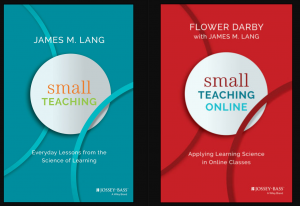The Lecture Doth Persist
Lectures, either in-class or by video, have their place in education but still too lofty a place. If they are too long they can become a waste of time and the format itself kills student interaction. Why do we persist in the lecture as primary means of teaching when research suggests there is a better way? (Dolcourt, 2000; Slavin, 1994) Jensen (2005) says that the appropriate amount of time for direct instruction of new content is maximum 18 minutes for adult learners. Is it any wonder that the insanely popular Ted talk format limits even their most famous presenters to 18 minutes? (download the official Ted talk speaker guide here) The following chart comes from Eric Jensen’s book “Teaching with the Brain in Mind” (2005, p.37).
GUIDELINES FOR DIRECT INSTRUCTION OF NEW CONTENT
| Grade Level | Appropriate Amount of Direct Instruction |
| K-2 | 5-8 minutes |
| Grades 3-5 | 8-12 minutes |
| Grades 6-8 | 12-15 minutes |
| Grades 9-12 | 12- 15 minutes |
| Adult Learners | 15-18 minutes |
A student, depending on their age, can only absorb a certain amount of new information at a time. A variety of materials and active learning activities will help increase student engagement. Boettcher (2006) writes:
Learning is not a spectator sport. Students do not learn much just by sitting in classes listening to teachers, memorizing pre-packaged assignments, and spitting out answers. They must talk about what they are learning, write about it, relate it to past experiences, apply it to their daily lives. They must make what they learn part of themselves.
Lectures can be part of a full learning experience, but should never subsist as the whole.
Increasing Student Interactive Activities
Consider using one of the following interactive activities to help support the weekly learning objective. There are many online educational games for younger learners, but these hand picked options could potentially be used in higher education (post high school). I will periodically add-to and update this list:
- Ice Breakers
- Create a survey word cloud with https://www.polleverywhere.com
- List of online polling apps: http://higherelearning.com/using-live-polls-or-surveys-in-canvas-using-polleverywhere
- Drill & Practice
- Add Games to your classroom – here are my top picks and some research regarding instructional gaming
- Online flash cards and games using https://quizlet.com/
- In class or online learning games using https://kahoot.com/what-is-kahoot/
- Jeopardy Type Game (great for multiple categories / review) https://www.playfactile.com/
- Example from Dr. Blake Jones here: https://www.playfactile.com/blakejonesfallacy
- Online Group Work
- A collaborative document using google docs
- Create a digital sticky board and allow students to post ideas around a video, image or idea (sign up here: http://linoit.com/home )
- Create a collaborative, online wipe board ( https://awwapp.com/ or groupboard )- to have students draw a picture together or create an organizational chart
References
Boettcher, J. V. (2006). Ten best practices for teaching online: quick guide for new online faculty. Retrieved from http://damitamajetteomde610.com/otte-and-banke.php
Dolcourt, J. L (2000, Summer). Commitment to change: A strategy for promoting educational effectiveness. Journal of Continuing Education in the Health Profession, 20(3), 156-163.
Jensen, Eric. (2005). Teaching with the Brain In Mind, 2nd ed. ASCD, 37.
Slavin, R. E. (1994). Quality, appropriateness, incentive, and time: A model of instructional effectiveness. International Journal of Educational Research, 21(2), 141-157.



